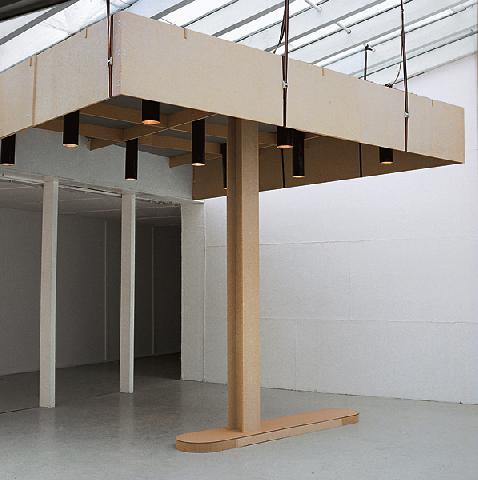This work references a typical drive-through gas station, a paradigm of functional architecture. The gas-station roof structure is transformed into a sculptural object through a series of formal strategies. While spatial and organizational analogies are unmistakably maintained, particular material and structural choices accentuate the representational nature of the overall composition. Pressboard and paper make up the usual concrete column and cantilevered roof. It is clear that the column is only a depiction as we can see that the roof is actually hung from the ceiling by multi-coloured belts. Sections of stovepipe inset with dim bulbs hang from this thin ceiling, standing in for industrial lighting. The aestheticization of this everyday architecture is thoroughly completed by a second sculpture, consisting of an identical roof section that is wedged into the end of a hallway in another area of the gallery. Here the roof is made into a sculptural object, not only by its materiality, but by its deformation, rendering it abstract and dysfunctional, while at the same time maintaining its representational status. Because these two assemblages are convincingly constructed at a human scale, we can immediately recognize and identify with them. Together, they allow one to engage in a shifted, parallel world, delicately assembled according to a logic of functionless appearance. Overall, Pit Stop employs a series of displacements in the "real" in order to reconsider the everyday environment, allowing us to see a typical condition anew.

Pit Stop
Project space FOE 156, Munic 1998
Pressboard, Cardboard, tension belts, lightbulbs
280 x 350 x 420 cm
Project space FOE 156, Munic 1998
Pressboard, Cardboard, tension belts, lightbulbs
280 x 350 x 420 cm